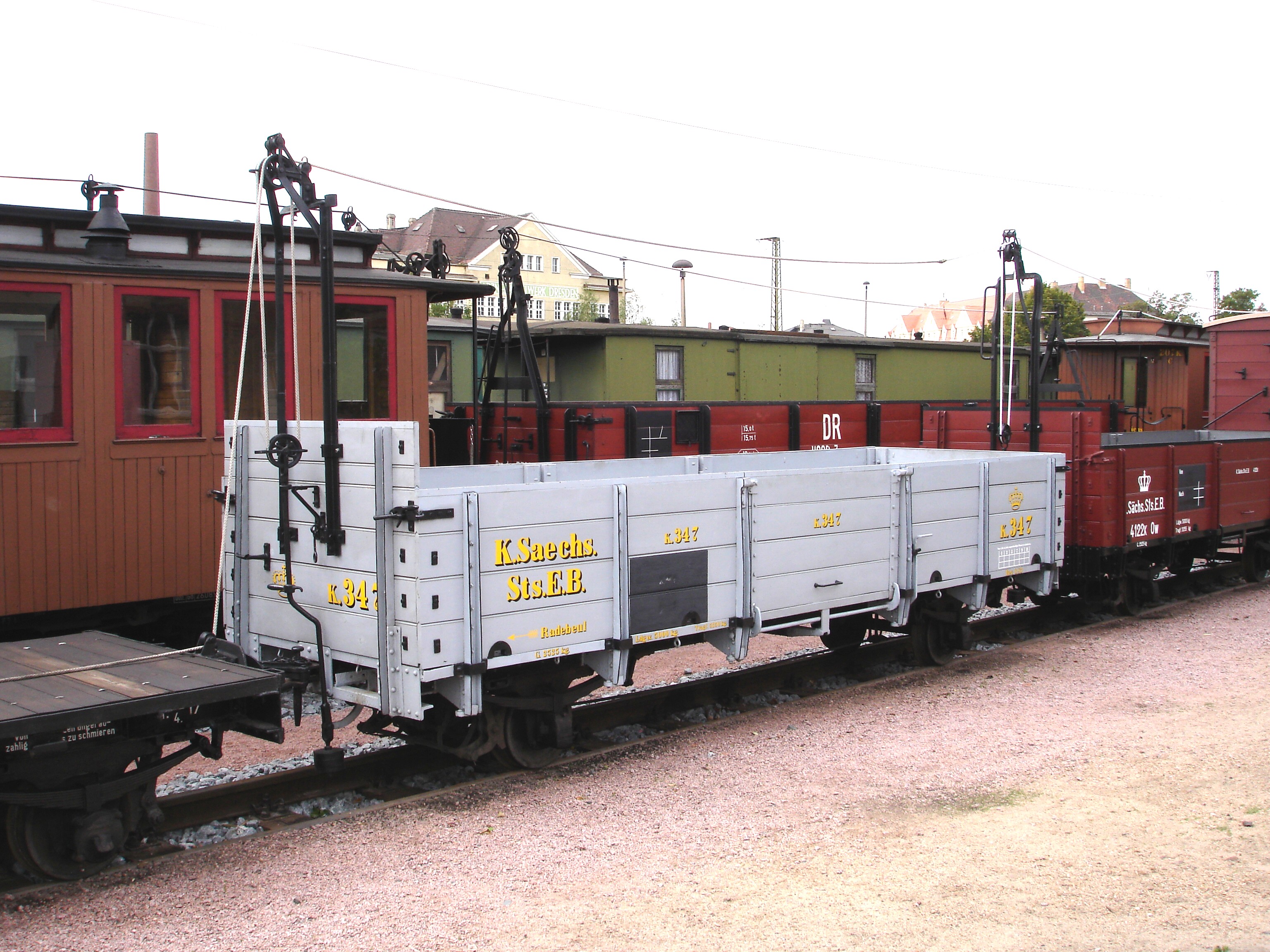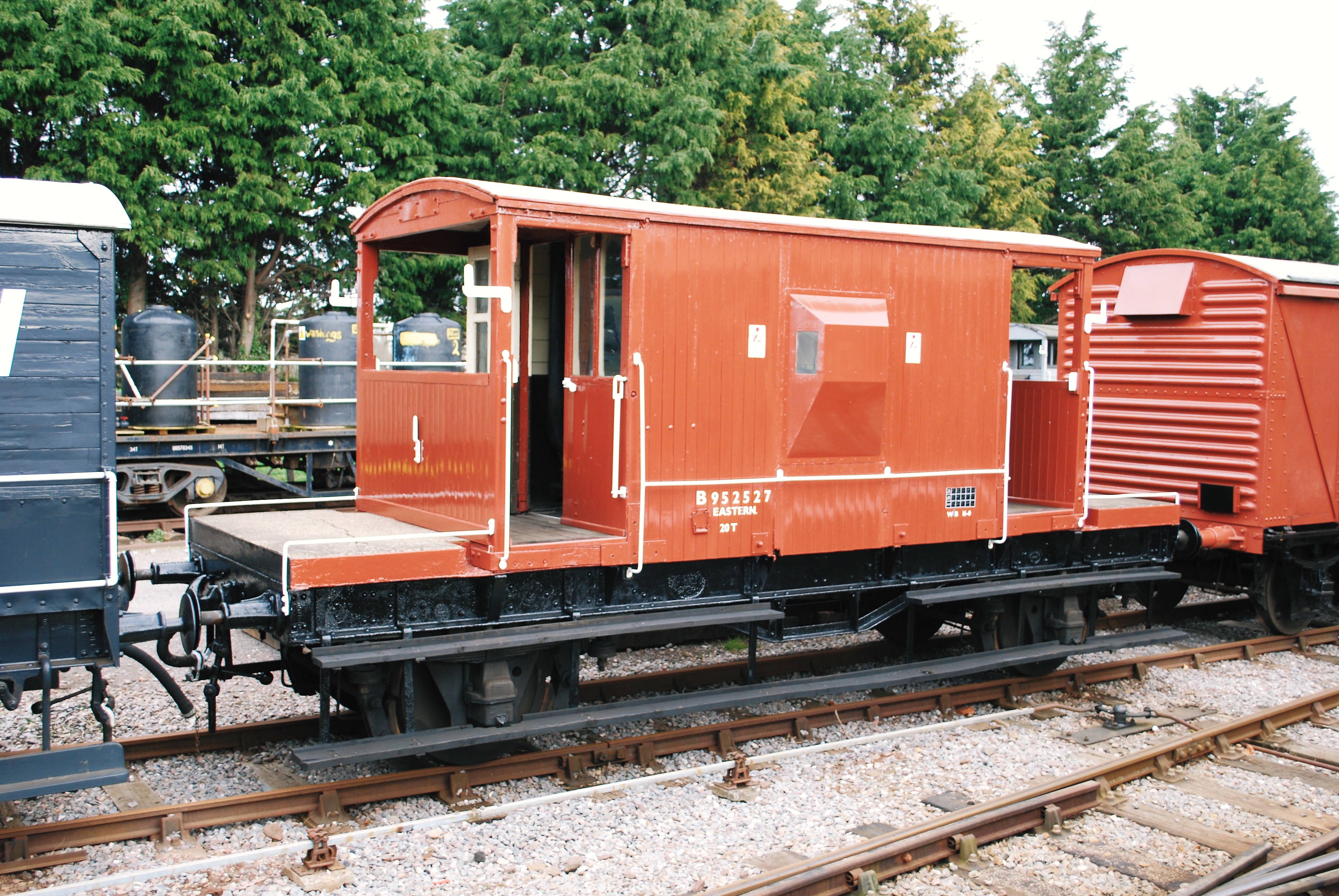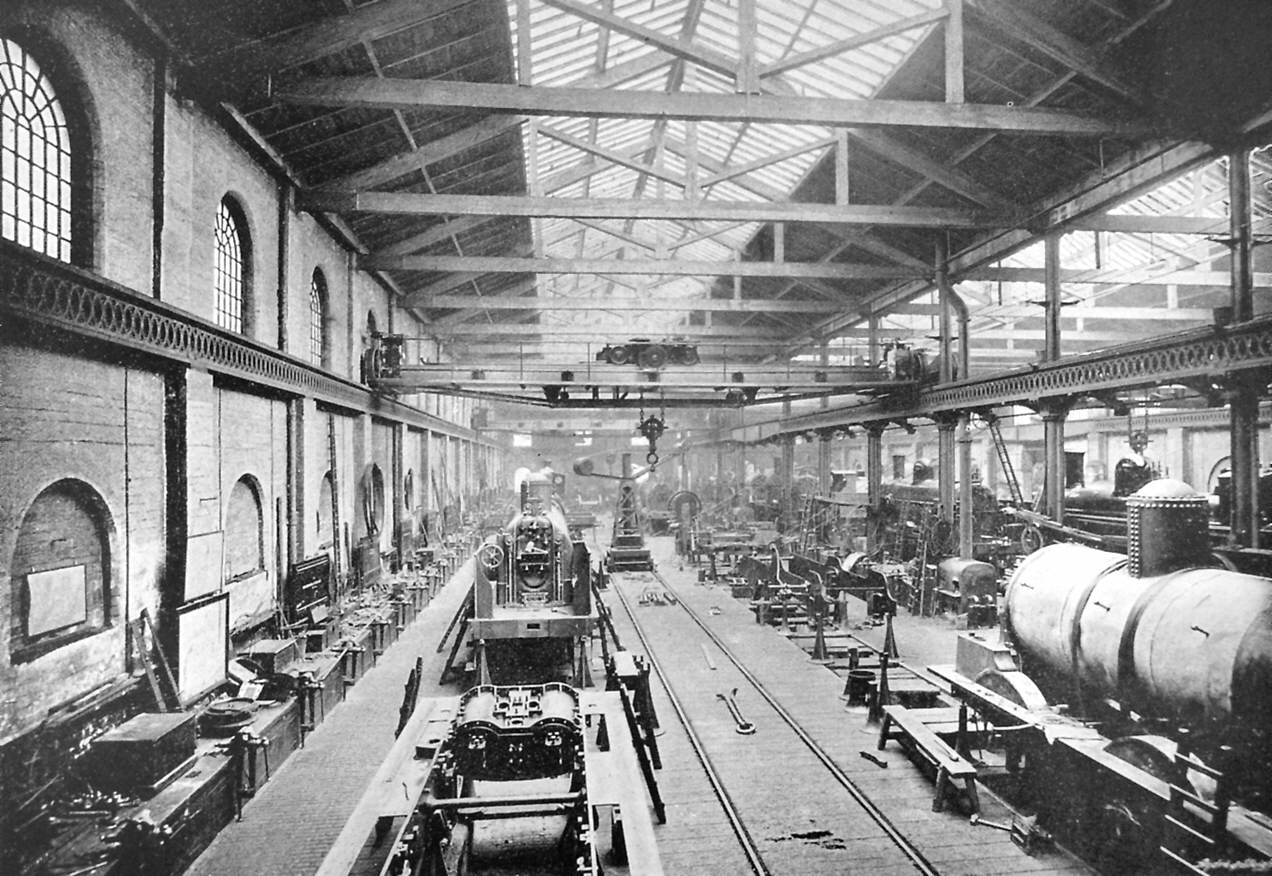|
Heberlein Brake
A Heberlein brake is a continuous railway brake used in Germany that is applied by means of a mechanical cable. Train braking is therefore initiated centrally from the locomotive using a winder. This causes the brake clips to be applied on individual wagons, assisted by a Servomechanism, servo system which makes use of the rotation of the axle. The brakes operate automatically if the cable snaps. A typical feature of ''Heberlein'' brakes is the clearly visible cable run on top of the wagons, but cables can also be led underneath the wagons, as on the ''Spreewaldbahn'' railway line. ''Heberlein'' brakes were eventually largely replaced by compressed-air brakes or, sometimes, by vacuum brakes on narrow gauge railway vehicles. Modern use The ''Heberlein'' brake is still permitted as an operating brake on German railways due to it being both continuous and automatic, and at the low speeds on narrow gauge lines this means it is perfectly safe. On several narrow gauge railways in Sax ... [...More Info...] [...Related Items...] OR: [Wikipedia] [Google] [Baidu] |
Rittersgrün
Rittersgrün is a district of the municipality of Breitenbrunn/Erzgeb., Breitenbrunn/Erzgeb in the Erzgebirgskreis in Saxony, Germany. The scattered settlement with around 1600 inhabitants grew up around several hammer mills, which operated on the course of the Pöhlwasser from the 15th to the 19th century and were supplied with ore from numerous surrounding mines. Due to its location on an important Ore Mountain passes, Ore Mountain pass, the settlement was repeatedly plundered by passing mercenaries during the Thirty Years' War. After the decline of the hammer mill industry in the middle of the 19th century, the village's economy was dominated by cardboard and sawmills. In 2007, Rittersgrün was incorporated into Breitenbrunn/Erzgeb. Today, Rittersgrün is primarily known as an excursion and winter sports resort. The main attractions include the Saxon Narrow Gauge Railway Museum and a well-developed network of hiking trails. Geography Geographical location Rittersgrün stre ... [...More Info...] [...Related Items...] OR: [Wikipedia] [Google] [Baidu] |
Mad River And Lake Erie Railroad
The Mad River and Lake Erie Railroad was the second railroad to be built and operated in the U.S. state of Ohio (the Erie and Kalamazoo Railroad was first, beginning operations in Toledo during the Toledo War in 1836). It was also the first railroad company chartered west of the Allegheny Mountains. History The railroad first broke ground in Sandusky, for construction on September 17, 1835 at the site which is currently Battery Park Marina. On November 17, 1837, the MR&LE took delivery of its first steam locomotive, '' Sandusky'', built by Rogers, Ketchum and Grosvenor of Paterson, New Jersey. ''Sandusky'' was also the first locomotive built by Rogers, Ketchum and Grosvenor, and the first to include features such as cast iron driving wheels and counterweights. The locomotive's transportation from New Jersey was overseen by Thomas Hogg. He was engineer for the locomotive for many years, and later became the railroad's chief mechanical engineer. The MR&LE used a rail gauge of ... [...More Info...] [...Related Items...] OR: [Wikipedia] [Google] [Baidu] |
Cincinnati, Hamilton And Dayton Railway (1846–1917)
The Cincinnati, Hamilton and Dayton Railway (CH&D) was a railroad based in the U.S. state of Ohio that existed between its incorporation on March 2, 1846, and its acquisition by the Baltimore and Ohio Railroad in December 1917. It was originally chartered to build from Cincinnati, Ohio, Cincinnati to Hamilton, Ohio, and then to Dayton, Ohio, Dayton, a distance of ; further construction and acquisition extended the railroad, and by 1902 it owned or controlled of railroad. Its stock and bond value plunged in late 1905 after "financial mismanagement of the properties" was revealed. The company was reorganized as the Toledo and Cincinnati Railroad in 1917. Acquisitions The original CH&D was founded by John Alexander Collins, who was born on June 8, 1815, in Staffordshire, England. He came to the US as a child in 1825, and worked as a locomotive engineer until moving to Ohio in 1851 to open the CH&D. Collins remained with the line until 1872, six years before his death in Covi ... [...More Info...] [...Related Items...] OR: [Wikipedia] [Google] [Baidu] |
Weverton, Maryland
Weverton is an unincorporated community hamlet located in the southern tip of Washington County, Maryland, United States, near the north shore of the Potomac River. Its population is about 500. Weverton is located at the intersection of MD Route 67 and U.S. Route 340. The nearest incorporated communities are Harpers Ferry, West Virginia ( to the west) and Brunswick ( to the east). Weverton's approximate elevation is above sea level. Weverton Cliffs, at the southern end of South Mountain where that ridge is interrupted by the Potomac River, are a landmark on the Appalachian Trail; they sit nearly at the halfway point of the trail and are well-known to through hikers. Weverton is the northwestern end of CSX Transportation's Metropolitan Subdivision, a 79-mile rail line that runs to Washington, D.C. History Founded in the 1820s, Weverton was a speculative venture intended to be a mill town to use the waterpower of the Potomac and transportation provided by the Chesapeake ... [...More Info...] [...Related Items...] OR: [Wikipedia] [Google] [Baidu] |
Hartford, Connecticut
Hartford is the List of capitals in the United States, capital city of the U.S. state of Connecticut. The city, located in Hartford County, Connecticut, Hartford County, had a population of 121,054 as of the 2020 United States census, 2020 census. Hartford is the most populous city in the Capitol Planning Region, Connecticut, Capitol Planning Region and the core city of the Greater Hartford metropolitan area with 1.17 million residents. Founded in 1635, Hartford is among the oldest cities in the United States. It is home to the country's oldest public art museum (Wadsworth Atheneum), the oldest publicly funded park (Bushnell Park), the oldest continuously published newspaper (the ''Hartford Courant''), the second-oldest secondary school (Hartford Public High School), and the oldest school for deaf children (American School for the Deaf), founded by Thomas Hopkins Gallaudet in 1817. It is the location of the Mark Twain House, in which the author Mark Twain wrote his most famous ... [...More Info...] [...Related Items...] OR: [Wikipedia] [Google] [Baidu] |
Brakeman
A brakeman is a rail transport worker whose original job was to assist the braking of a train by applying brakes on individual wagons. The advent of through brakes, brakes on every wagon which could be controlled by the driver, made this role redundant, although the name lives on, for example, in the United States where brakemen carry out a variety of functions both on the track and within trains. By country Germany In Germany, the brakemen occupied brakeman's cabins on several or even all wagons in a train and would operate the wagon brakes when signaled by the engine driver. It was a dangerous and uncomfortable role, especially in winter when it was not uncommon for brakemen to freeze to death in the unheated cabins. The implementation of air brakes led to the phasing out of brakemen who previously operated manual brakes from brakeman's cabins. While the construction of brakeman's cabins ceased around 1925, existing wagons with such cabins remained in use for several ... [...More Info...] [...Related Items...] OR: [Wikipedia] [Google] [Baidu] |
Brake Van
Brake van and guard's van are terms used mainly in the UK, Ireland, Australia and India for a Rolling stock, railway vehicle equipped with a hand brake which can be applied by the Conductor (transportation), guard. The equivalent North American term is caboose, but a British brake van and a caboose are very different in appearance, and use because the former usually has only four wheels, while the latter usually has bogies, as well as American Cabooses not being used to provide braking on a train, and instead serving as a mobile office for the Conductor_(rail), conductor and the Brakeman, brakemen who helped monitor the train. German railways employed brakeman's cabins combine car, combined into other cars. Many British freight trains formerly had no continuous brake so the only available brakes were those on the locomotive and the brake van. Because of this shortage of brake power, the speed was restricted to . The brake van was marshalled at the rear of the train so both por ... [...More Info...] [...Related Items...] OR: [Wikipedia] [Google] [Baidu] |
London And North Western Railway
The London and North Western Railway (LNWR, L&NWR) was a British railway company between 1846 and 1922. In the late 19th century, the LNWR was the largest joint stock company in the world. Dubbed the "Premier Line", the LNWR's main line connected four of the largest cities in England; London, Birmingham, Manchester and Liverpool, and, through cooperation with their Scottish partners, the Caledonian Railway also connected Scotland's largest cities of Glasgow and Edinburgh. Today this route is known as the West Coast Main Line. The LNWR's network also extended into Wales and Yorkshire. In 1923, it became a constituent of the London, Midland and Scottish (LMS) railway, and, in 1948, the London Midland Region of British Railways. History The company was formed on 16 July 1846 by the ( 9 & 10 Vict. c. cciv), which authorised the amalgamation of the Grand Junction Railway, London and Birmingham Railway and the Manchester and Birmingham Railway. This move was prompted, in ... [...More Info...] [...Related Items...] OR: [Wikipedia] [Google] [Baidu] |
Counterweight Brake
A counterweight brake () is an early form of hand brake on railway tenders and tank locomotives. By throwing a counterweight lever, play in the brake blocks is quickly taken up and braking action is initiated. Further movement of the lever increases the transmission so that the blocks are pressed against the wheel tyres with greater and greater force. On locomotive tenders the counterweight brake generally acts on all the axles, whilst on tank engines the braking action is only applied to the driving and coupled wheels. See also * Emergency brake (train) On trains, the expression emergency brake has several meanings: * The ''maximum'' brake force available to the engine driver from the conventional braking system, usually operated by taking the brake handle to its furthest position, through a ga ... * - to follow Literature * ''Lexikon Eisenbahn'', Transpress Verlag für Verkehrswesen, Berlin, 1978 Railway brakes {{rail-transport-stub ... [...More Info...] [...Related Items...] OR: [Wikipedia] [Google] [Baidu] |
Preßnitztalbahn
The Pressnitz Valley Railway (German: ''Preßnitztalbahn'') was a narrow gauge railway line in Saxony, Germany. It used to climb from Wolkenstein on the standard gauge Annaberg-Buchholz–Flöha railway through the valley of river Preßnitz (Czech: ''Přísečnice'') to Jöhstadt on the border with Bohemia. It was dismantled in the second half of the 1980s, however the Steinbach - Jöhstadt section was rebuilt as a museum railway after the fall of communism in East Germany. History Construction started in 1891 and the railway was opened on 1 June 1892. In May 1893 the line was extended to the border with Bohemia. There were several projects to connect the line to Bohemian standard gauge lines, with the aim of enabling the importation of lignite from the Most Basin. However, the proposed link with border station at Reitzenhain on the Chomutov–Reitzenhain and Reitzenhain–Flöha railway lines was rejected, as well as plans to build an extension to the Chomutov–Vejprty/R ... [...More Info...] [...Related Items...] OR: [Wikipedia] [Google] [Baidu] |





